Home » Other Articles » Going Loco Index » Going Loco - April 2023 - Going Loco - April 2023
Going Loco - April 2023
FRIDAY 28 APRIL
The Other Blue King
Didcot is home to a wonderfully representative slice of steam power from the mighty Kings and Castles, to the tiniest shunters. We are also home to two ‘Kings’. We are clearly not solely talking about the massively powerful Collett-designed 4-6-0 that is No 6023 King Edward II! The other King, despite her regal name, is a rather more humble machine but of no less importance of purpose.

King George running on the main demonstration line
Her story starts way back in 1864 with the founding of a locomotive works at Jack Lane in Hunslet, Leeds. Its founder was a man possessed of one of those fantastic Victorian names – John Towlerton Leather. He was a civil engineering contractor and he was responsible for many military construction projects – a massive extension to Portsmouth Dockyard and the building of sea forts at Spithead, St Helen’s Fort and Fort Gillicker. Unfortunately, he was also involved in the construction of Dale Dyke Dam – the collapse of which caused the Great Sheffield Flood on 11 March 1864. This resulted in the loss of over 250 lives and massive property damage. The disaster was at least in part put down to poor quality work on the structure.
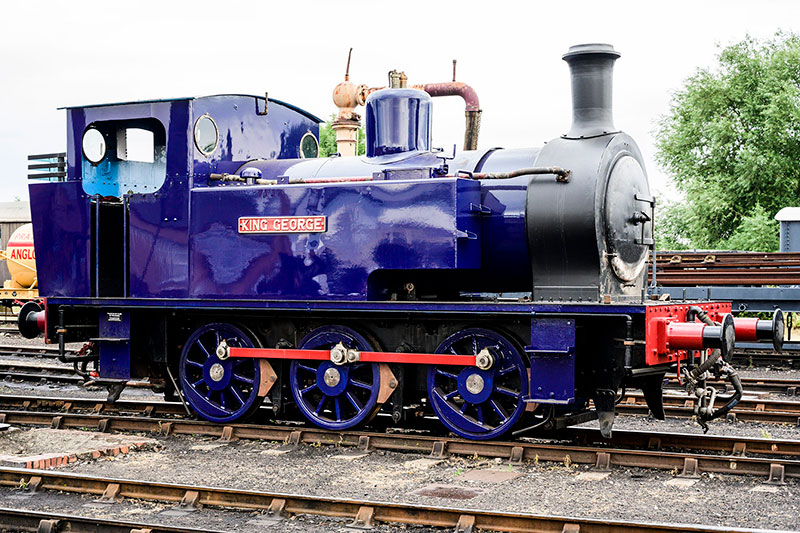
King George in July 2022, painted but not yet lined
The first engine built by the Hunslet Engine Company was really a trend setter for them and it was the basic formula that made them successful for many years. Completed in 1865, she was a simple 0-6-0 saddle tank called Linden. She was delivered to her new owners, the civil engineering company Brassey & Ballard, shortly afterwards. This became Hunslet’s staple product – smaller shunting engines, not designed to go long distances but powerful for their size. Economic and easy to look after. Ideally suited to the industrial environments that they inhabited.
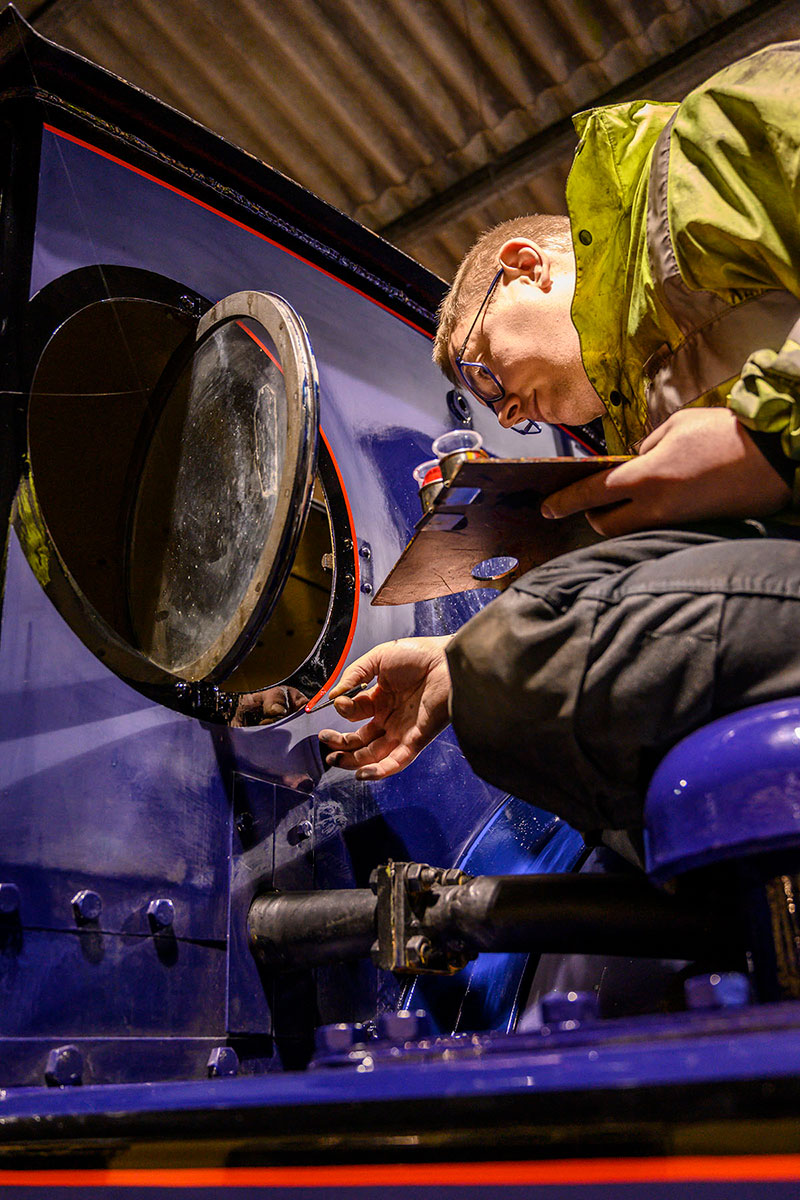
Adam Meredith applying the intricate lining out
In the early 1870s, a few milestones were reached. The company was bought by James Campbell and it remained the property of his family for a long time afterwards. It also diversified into its first narrow gauge locomotives. Of particular note is the design that is today known as the ‘Quarry Hunslet’. This became a particular favourite in the slate mines of North Wales and is an integral part of the history of the area.
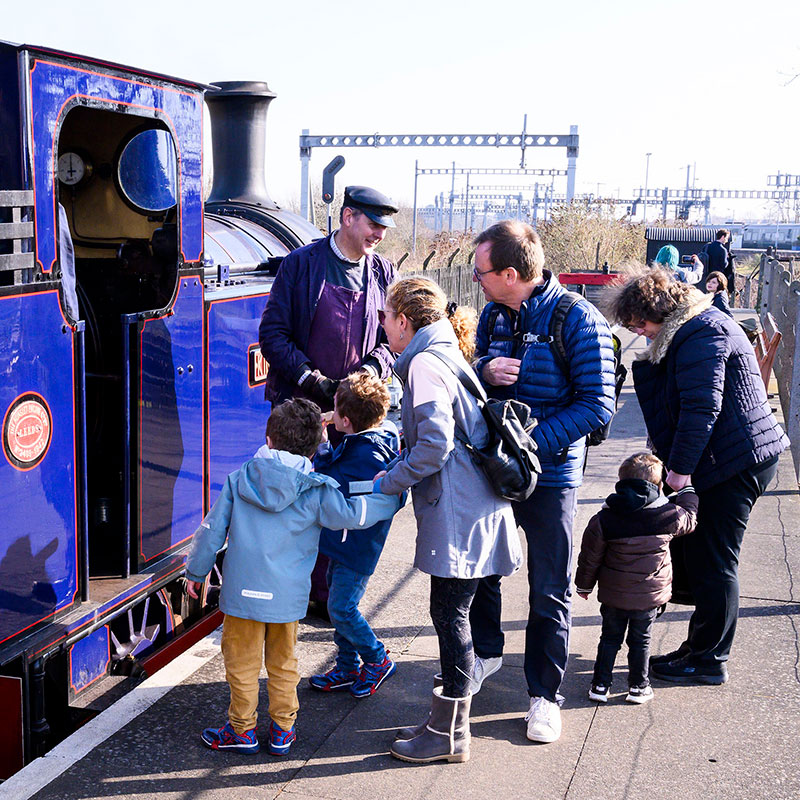
Children enjoying a close-up view of the locomotive
In the style of British engineering firms during the age of empire, Hunslet exported its products all over the world. Australia to Sierra Leone. Ireland to Indonesia. Even Chile and Bolivia purchased its products. Imperial possession or not, the name of Hunslet was known everywhere. During the Great War, Hunslet served. It built the famous 4-6-0T narrow gauge trench locomotives. Hunslet survived the Great Depression and acquired the rights and patterns to build machines from several defunct manufacturers including Kerr, Stewart and Co and Avonside.
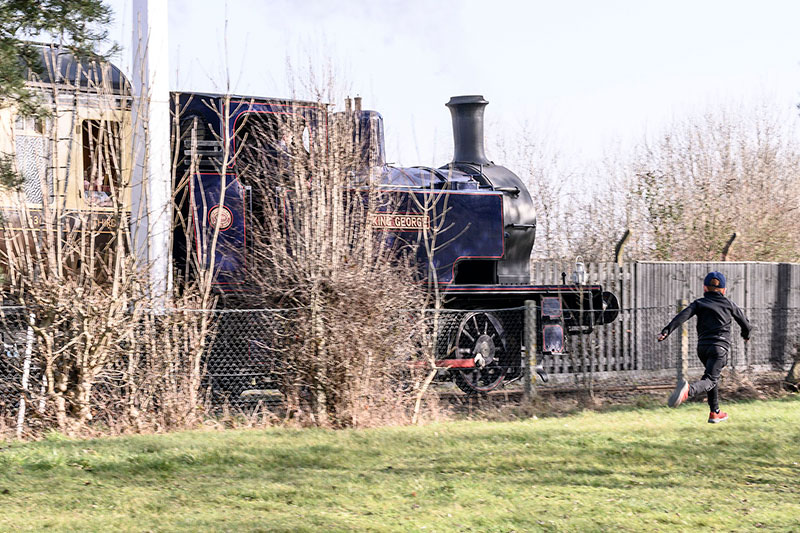
It’s fun to run alongside the train on the grass in the picnic area
Hunslet produced the designs for the famous 0-6-0 ‘Austerity’ saddle tanks during the Second World War. It was one of the more forward thinking of the British locomotive builders and was at the forefront of diesel traction as early as the 1930s. The end of steam production came in 1971 with an order for export to Trangkil Sugar Mill in Central Java, Indonesia. The company was obtained by LH Group in 2004 and this was subsequently obtained by Wabtec in 2012 and then the group was brought by Ed Murray and Sons in 2021. It still deals with spares and maintenance for a wide range of old British locomotive manufacturers so the company in one form or another still exists.
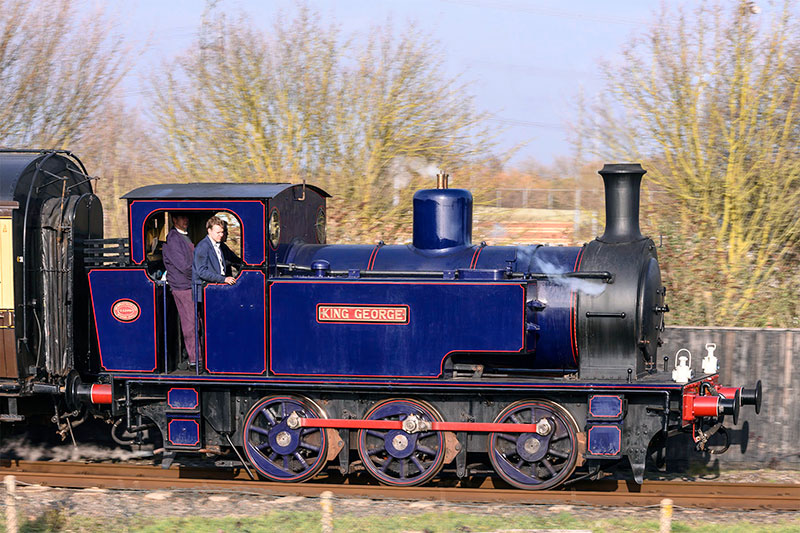
A broadside view of King George
Our Hunslet was built in 1942 and was delivered on 20 May that year. The engine is of 0-6-0 wheel arrangement and was built as a saddle tank. She is similar in design to the Austerity 0-6-0s but has a shorter saddle tank with an exposed smokebox. During her working life, No 2409 King George was always a colliery shunter, starting at Linby Colliery, Nottinghamshire. She moved to Bestwood Colliery in 1959 and finally to Gedling Colliery in 1960.
She was purchased from service by a company called Titanic Steam Ship Enterprises and was moved to Ecclestone although she was subsequently sold for scrap to Jeremy Walker of Witney in Oxfordshire but was saved from this ignominious end and taken to our friends at the Gloucester and Warwickshire Railway. Here she was an early stalwart and arrived on 28 June 1981. She was restored at Toddington and painted in a lined red livery. She was the first preserved steam locomotive to reach Cheltenham Racecourse in February 2001.
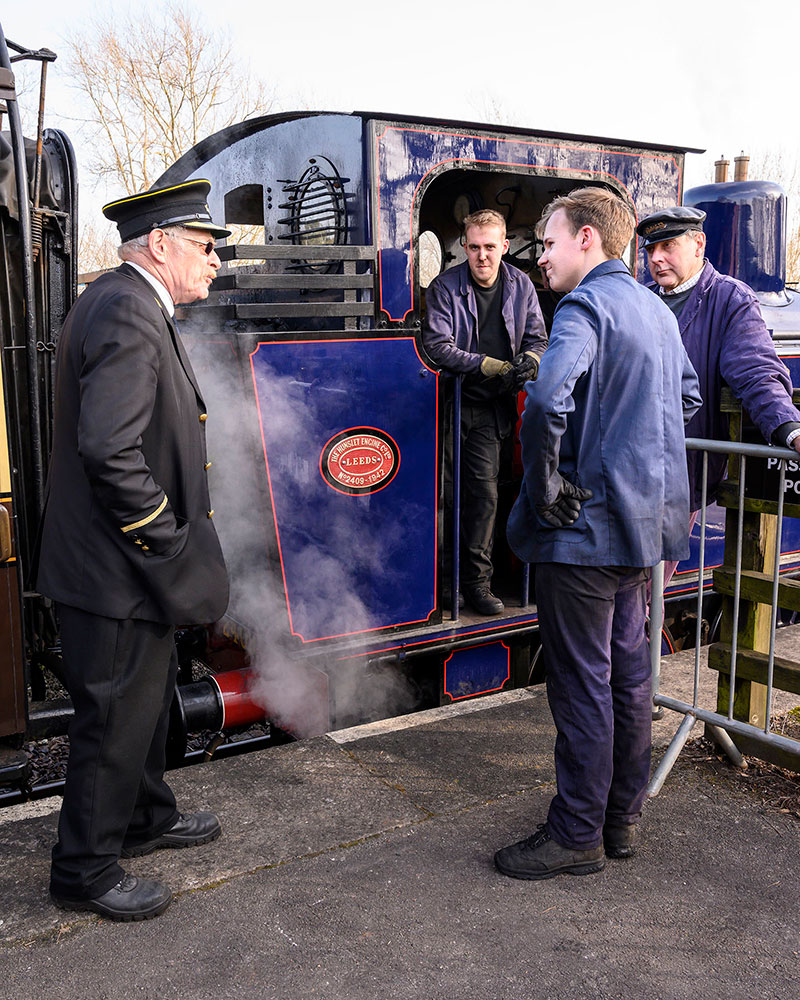
The train crew enjoying a chat, with the locomotive’s works plate prominent on the bunker
No 2409 was purchased by the Great Western Society in 2011 and was dismantled for overhaul. She was rebuilt as a side tank engine for reasons we won’t go into but are probably pretty obvious if you know anything about British popular children’s entertainment. This however was a bit of a red herring and the running of these events has become far too difficult for a number of reasons. The refitting of the saddle tank was considered but it isn’t in great condition and the rest of the locomotive was ready to go so, for now, the side tanks remain. The saddle tank still exists however and the option to put it back in future once it has been restored is still there.
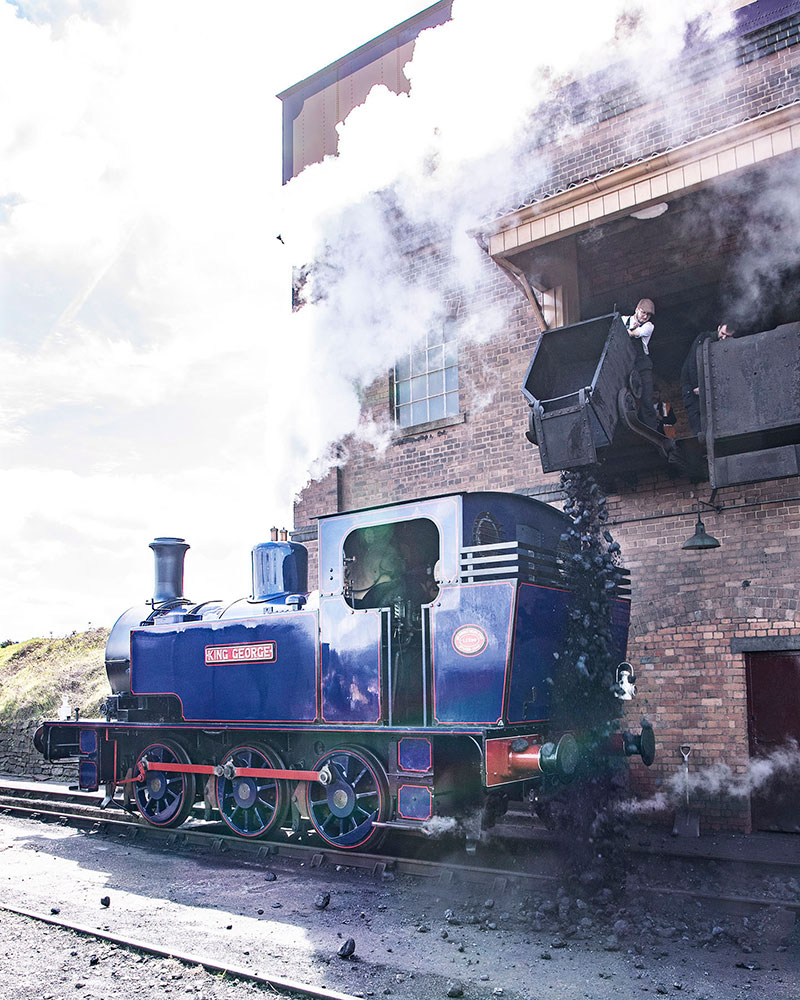
Filling the bunker at the coal stage
As such, the decision was taken to have a little ‘Blue King’ brother to go with our other one! I think she looks rather smart in the dark blue quasi Great Eastern livery. She’s also a lovely engine to operate. Easy going, steams on very little coal and is economical with water. So King George is here to stay and she’s a rather good addition to the fleet. The Great Western was connected to a great many rail served industries that had their own internal rail networks. Close to London there were several – the Slough Estates Railway and Huntley and Palmers at Reading are just two. So it is fitting that No 2904 and No 1 Bonnie Prince Charlie have found a home with us at Didcot. Another facet of the story of the GWR told through the amazing collection of artefacts we are proud to look after.
King George is due to be in steam for the coming bank holiday weekends and throughout this year. Why not come and meet our little monarch?
FRIDAY 21 APRIL
A Specific Pacific
It struck me the other day that, having talked to you about the Stars, the Castles and the Kings, we have kind of got an odd man out here. There was one more 4-cylinder Great Western Railway express passenger locomotive built. She no longer survives in preservation but despite this has gained a near legendary status amongst railway enthusiasts. The only Pacific (4-6-2 wheel arrangement engine) that the GWR ever built. I am of course talking about No 111 The Great Bear.

The Great Bear in her early days at platform 1 of Paddington station. Photograph by J N Maskelyne
The mythological status of this engine is due to many reasons. Not least of which is the reason why on Earth she was constructed in the first place. The Western was focused on producing locomotives of the 4-6-0 wheel arrangement and this became the norm until the end of steam traction on the railway. Historians have proposed several versions of events. One common suggestion is that the board of directors were seeking publicity and having the biggest passenger locomotive in the UK wouldn’t have hurt this!

Comparison drawings of The Great Bear and a 28XX 2-8-0 goods engine. As built The Great Bear had a set of footsteps, which were soon removed, at the front just ahead of the outside cylinders
Some have said that it was purely down to George Jackson Churchward and his desire to keep locomotive development going at Swindon. Of particular interest to Churchward was the development of boiler technology and No 111’s boiler was to take the Swindon style of steam plant to a larger scale. Yet another theory is based upon a comment made by Churchward to the GWR board that is recorded in the minutes of a meeting – to the effect that while his new locomotive, No 40 North Star, was the latest thing in steam technology now and that a Pacific was too big for the current situation, he could foresee a time that such a design could be required. He also mentioned that it was already on the drawing board.

The Great Bear at Twyford at the head of a train, the first three carriages of which are 70 ft long Dreadnoughts
Whatever the reason, the order for No 111 under Lot 171 was issued in January 1907. And what a big difference it was! This engine was very different to anything the GWR had built before. The pacific wheel arrangement was relatively young at the turn of the 20th century. The Lehigh Valley Railroad in the USA had built two engines of that wheel arrangement in 1887. This was due to the extra support needed for the unusual ‘Strong’s Patent’ firebox design. Another 4-6-2 happened in America at the Chicago, Milwaukee and St Paul Railroad in 1889, but this again was an add on to try to reduce the axle weight on the locomotive. The West Australian Government Railways got in on the act by producing a class of six ‘Q class’ 4-6-2 tank engines in 1896.
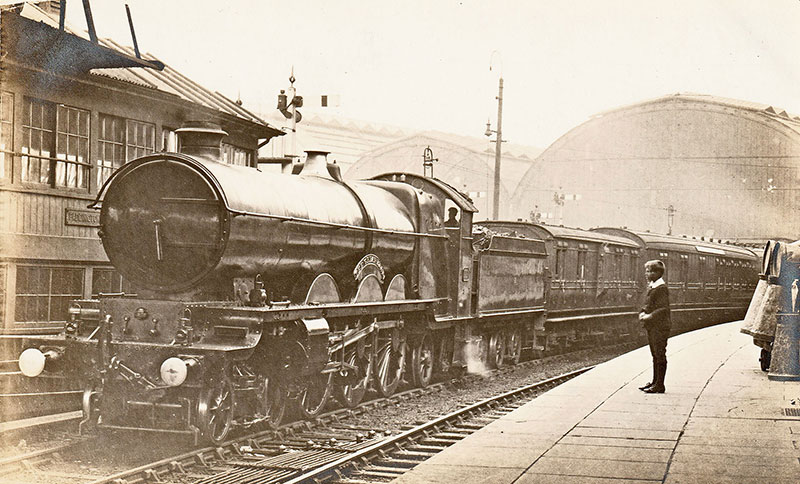
The Great Bear ready to depart from Paddington station
The first engines of what we would easily recognise as being a Pacific were built to an order in 1901 from the New Zealand Railways Department to the Baldwin Locomotive Works in the USA. The big advantage for these types of engine being used in New Zealand was that the firebox was mounted above the rear carrying wheels. This meant that a wide firebox could be employed. A wide firebox is really useful if the coal you burn is of poor quality, as is the case with the supply of lignite coal from the South Island of the nation. So the Pacific design was basically there and really didn’t change much until the end of steam traction around the world. There were thousands of engines built to this same pattern and they were highly successful.
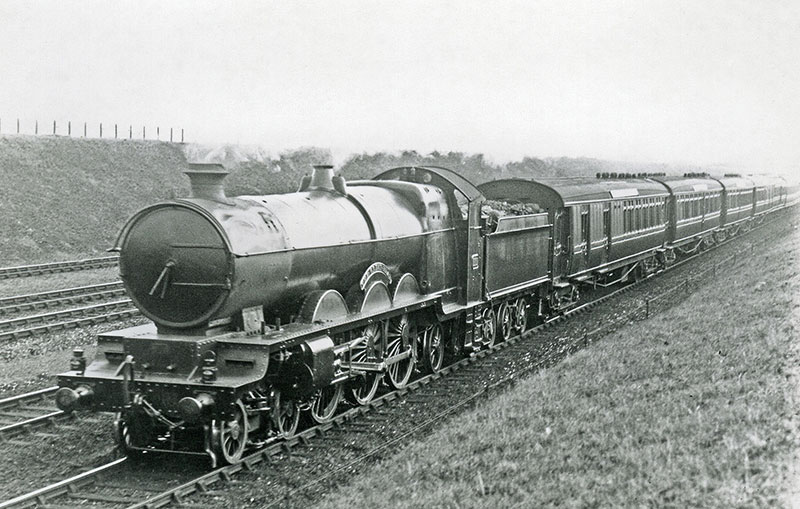
The Great Bear, again with Dreadnoughts as the leading carriages
Which is why some of Churchward’s design decisions for No 111 were a little odd to modern eyes. Firstly, most Pacifics also have their trailing wheels suspended on bearings mounted on the outside of the wheels. Churchward mounted his inside the frames. This was also weird because his 4-4-2 Atlantic test locomotives all had outside bearings on their trailing wheels. One result of The Great Bear’s inside bearings was aesthetic. Adding the eight-wheel tender, each side had a procession of ten wheels on view to accentuate the size of the combination.
The other unusual thing was the length of the cylindrical section of the boiler. The barrel on this engine was long. Really long. 23 feet long in fact. Churchward used the vast majority of the rest of the machinery from his already popular Star class 4-6-0s. Thus was conceived the first ever Pacific built to run in the U.K.
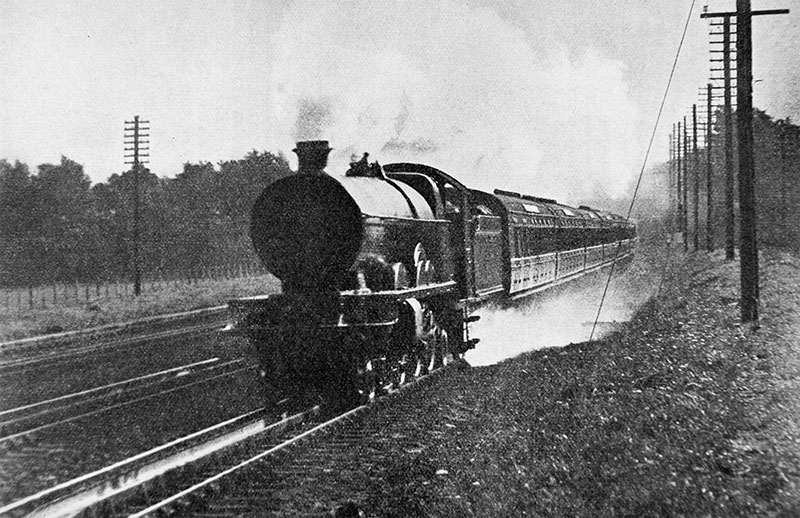
The Great Bear picking up water on Goring troughs
She was an impressive looking beast but had her issues. The elongated boiler and wide firebox meant that careful handling by the fireman was in order. She had a rather less than entertaining habit of overheating the bearings on those trailing wheels. The engine wasn’t really that much more powerful than the Stars and there was one other glaring problem. Her weight. At the time the vast majority of Great Western routes weren’t capable of withstanding the forces put down through No 111’s wheels to the track. She had an axle loading of over 20 tons and this highly restricted her use. Thus she spent the vast majority of her time going between London Paddington and Bristol.

The Great Bear hauling the 6.30 pm train from Paddington to Bristol on 18 May 1914. Photograph from the LCGB Ken Nunn collection
There were several attempts to improve the performance of The Bear, but they only had limited success. The engine wasn’t a success in terms of her abilities but she was, for a time, a publicity icon for the GWR. This development and publicity all came to an end with the beginning of WWI. While she was used for a time after the armistice, with Churchward’s retirement in 1922 and the advent of the Castle class in 1923, her relevance faded. By 1924, The Great Bear was in need of a heavy overhaul. The decision was taken to rebuild the engine to become a Castle class locomotive. Not much of the engine survived the conversion. The number plates did but that evocative name did not. Upon her release back into traffic, she was renamed Viscount Churchill.
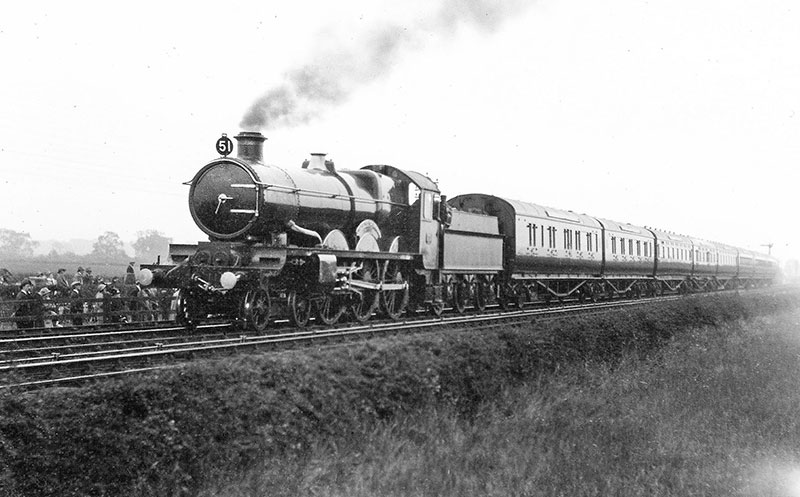
No 111 newly rebuilt as a Castle named Viscount Churchill and exhibited at the 100th Anniversary of Railways parade near Goosepool on 2 July 1925. The leading carriages are articulated sets. Photograph from the LCGB Ken Nunn collection
The Great Bear was regularly driven by Driver Blackall from Oxfordshire and had racked up just over half a million miles. Rebuilt into Viscount Churchill, she soldiered on and was eventually withdrawn and scrapped in July 1953. The Great Bear continues to be an enigma. Even today the reports of what Churchward thought about it are mixed from somewhere between being thoroughly unimpressed to being quite fond of her. Whatever the truth, the engine was an interesting off shoot of Swindon locomotive practice and presents one of those fantastic ‘what if?’ propositions. If she had been designed slightly differently, perhaps she would have been a truly great bear and not the white elephant she became.
FRIDAY 14 APRIL
A Convertible But not a Soft Top…
Leading on from our Victorian Weekend and the fun times had with our visitor, Furness Railway No 20, it struck me that the only Victorian coach we have ever talked about in detail is the Dean Family Saloon No 2511 (Going Loco 2 September 2022). While that is a truly significant survivor and fittingly celebrated, we do have a fantastic selection of other Victorian passenger vehicles. There are two vehicles in the collection that are of great significance for a key point in the history of the Great Western Railway.
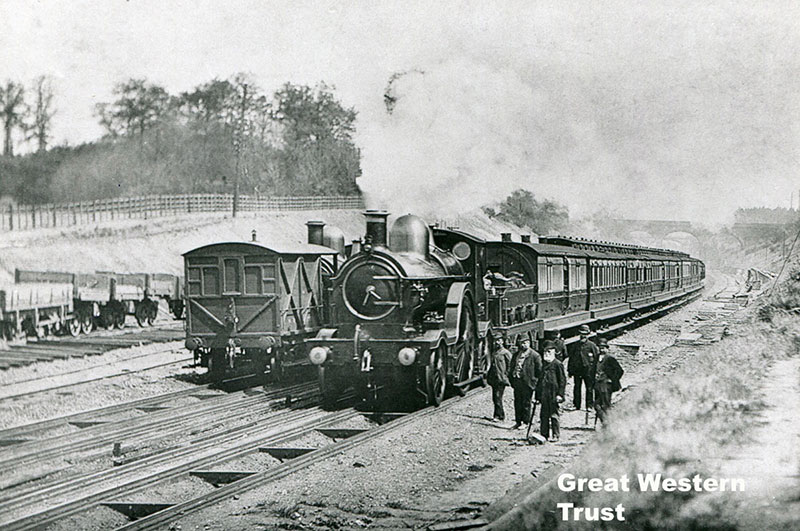
A rather ungainly 3031 class locomotive running on broad gauge wheels in May 1892, but easily convertible to standard gauge
The genius of Isambard Kingdom Brunel is beyond doubt. His plan to use a wider track gauge than was popular at the time, Brunel’s broad gauge, gave the trains a lower centre of gravity. Wider trains had more capacity and space to make their engines larger and more powerful. Sadly though, the 4’ 8½” gauge popularised by George Stephenson, father of Brunel’s great friend Robert Stephenson, had already gotten a hold of the railways of Great Britain.
Brunel’s 7’ 0¼” broad gauge was the loser in the format war. It was fast becoming just so much Beta-Max video cassettes*. The biggest downside from the GWR’s point of view was the transhipment of both passenger and goods where the now standard gauge met the broad. It was time consuming and expensive, causing the company all sorts of issues.
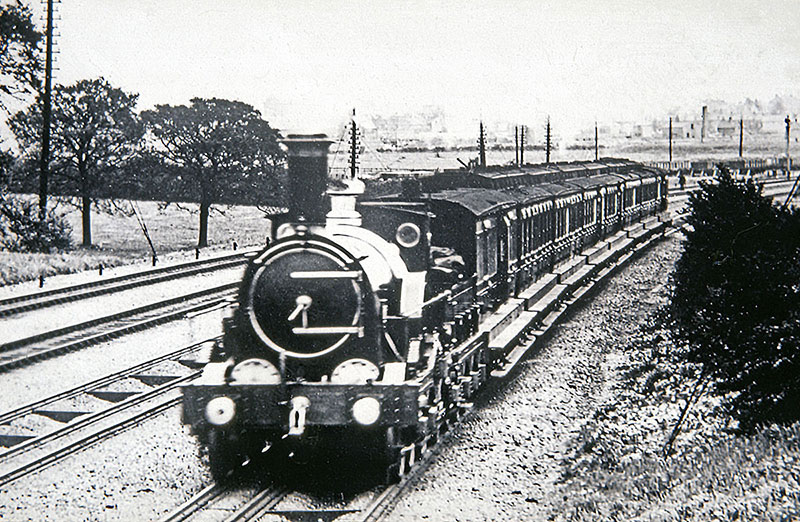
The wide footboards of the carriages show they have bodies to fit the standard gauge loading gauge, but are temporarily running on broad gauge bogies
An act of parliament eventually forbade any further building of new broad gauge railways. This meant that the broad gauge had a shelf life and that it was fast running out. From the middle of the 19th century, this was clear, but there was a rapidly growing issue. The rolling stock and locomotives of the broad gauge were all starting to wear out. On the one hand, the urge is to replace them but that would be a wasted investment for as soon as the broad gauge was gone, the locomotives and rolling stock became obsolete. This is where some thinking was done at Swindon Works.
If you designed your new rolling stock to be able run on the broad gauge, but later be capable of modification to fit on standard gauge track? These became known as the convertible stock and there was a wide range of different vehicles under this umbrella. There were a number of locomotives that were so devised as well as rolling stock. The idea was that the body of the coach was designed to fit within the loading gauge** of the standard gauge and yet for it to a chassis that had broad gauge wheels. These convertibles bridged the gap between the last years of the broad gauge and the conversion to the standard gauge.
We have two representatives of this era at Didcot. They are also both what is known as tri-composites. Unlike today, where there is standard class and first class accommodation on trains, there was an extra choice in comfort levels. As per the rigid class society in Victorian society, the upper, middle and lower classes were represented by first, second and third class compartments. It was only in the early 1900s that the second class was removed on the GWR. The second class compartments were thus downgraded to third class. This led to the weird situation where there was a first class, third class and lots of questions as to where the one in the middle went!***
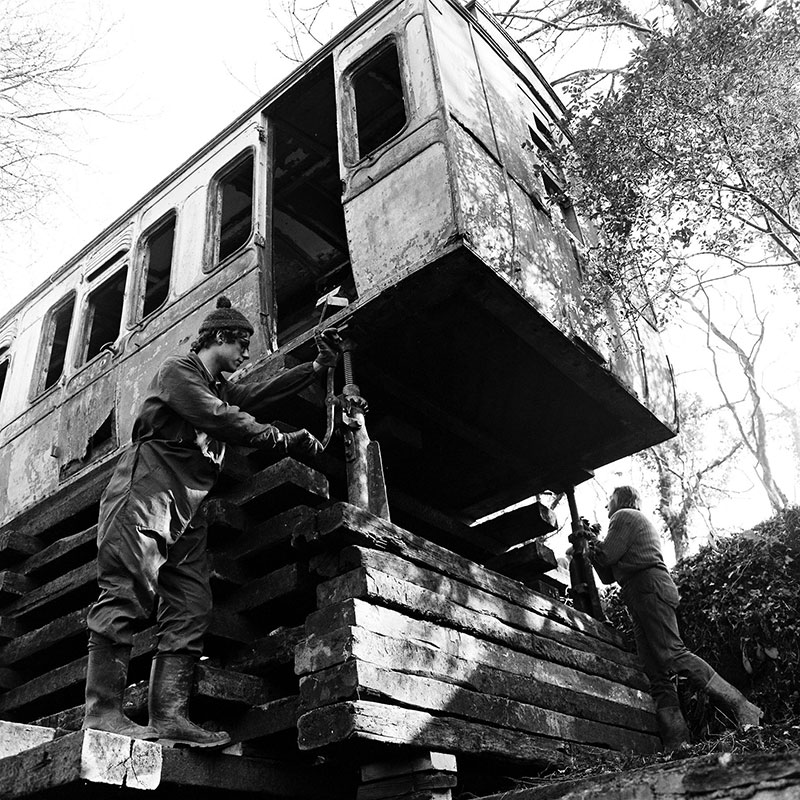
No 6824 being jacked up from her position on a Welsh hillside for recovery to Didcot in 1974
The first one of these to enter preservation with the Society was No 6824. This vehicle was built in 1887 to diagram U29 as part of Lot 370. Carriages of this diagram had a luggage compartment in the middle, one first and one second class compartment either side of the luggage, and two third class compartments – one at each end. She was built with oil lighting – which goes to prove her vintage! She was updated to gas lighting in 1896. During her career, she also gained steam heating gear and for a short period before WWI, had Westinghouse air brake equipment for through workings to other railways. After a long career, she was withdrawn in November 1932. The coach body was removed and was used in various roles, ending up on a Welsh hillside from where she was preserved in the mid 1970s. As it stood, it was the only one of these the Society was ever going to get so a 6-wheel chassis from an LMS ‘STOVE R’ six wheeled covered carriage truck was found, and the body was put into the carriage store resting on top of it.
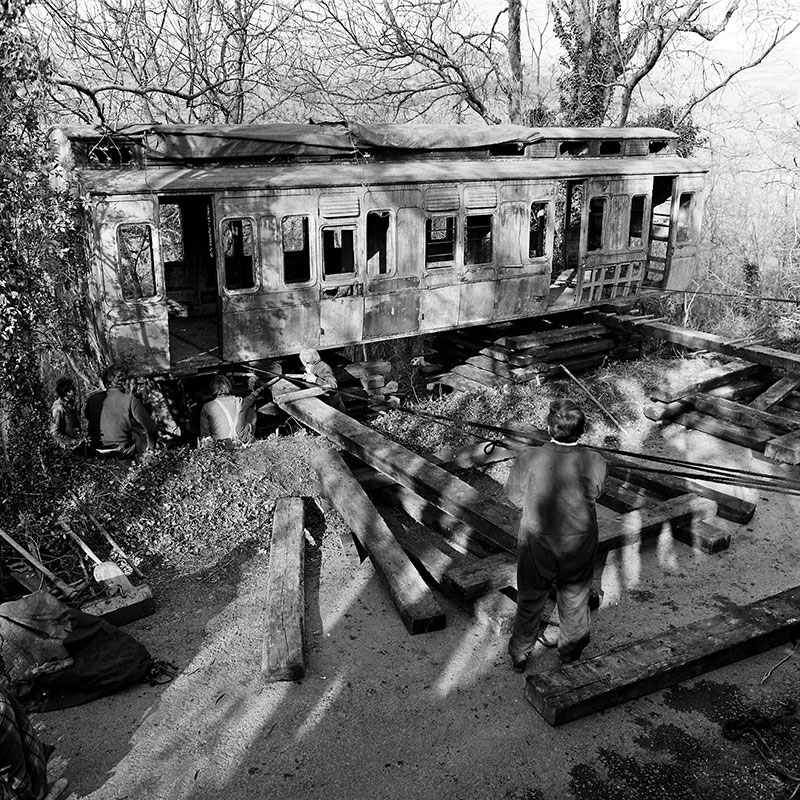
Once jacked up to road level, No 6824 was traversed across to be loaded onto a lorry for the journey to Didcot
The second diagram U29 coach had a very different history after being withdrawn from passenger service. No 820 was also built in 1887 as part of the same Lot 370. She was withdrawn from passenger use much later than No 6824, working right up to 1952. This was unusual for a 4 or 6 wheeled coaches and as such, it went to be used as a departmental vehicle. The big difference between the two vehicles is that, apart from its interior, she has a full set of original running gear. This includes the now rare external Dean clasp brake gear. She was saved from departmental use by the Bristol Museum Service and thence became part of the National Collection. In their care, she was displayed in the NRM Museums at York and Shildon and Steam Museum at Swindon.
Her last home was at Shildon, where the National Collection decided to put up No 820 for relocation and new ownership. Clearly, such a significant coach would be the ideal complement to the extensive vintage carriage collection that the Society already has. The Society’s bid was successful and she became a part of our collection. Transported by road from Shildon to Didcot, she took the short trip across the GWR main line – for the first time in well over half a century – on 7 May 2022.
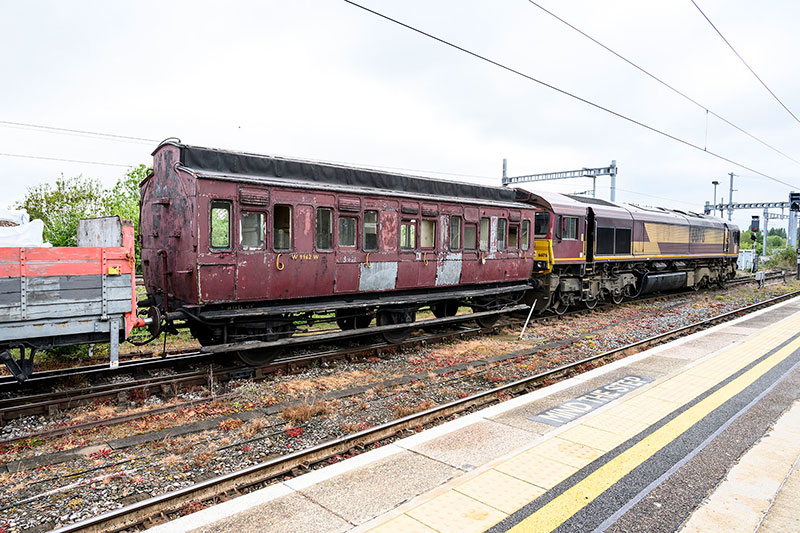
No 820 en route from Didcot West Yard to the Railway Centre
The future plan for No 820 is to restore her to full running order and in the condition she was in when the broad gauge became the standard gauge, thus preserving her rare running gear. Given that No 820 is in such good condition and that we have just the body of No 6824, the options for the second vehicle are much broader in scope. This might include the option to rebuild her to the broad gauge version of these coaches and provide a tangible reminder of that pivotal part of the history of the Great Western – the end of the Broad Gauge.
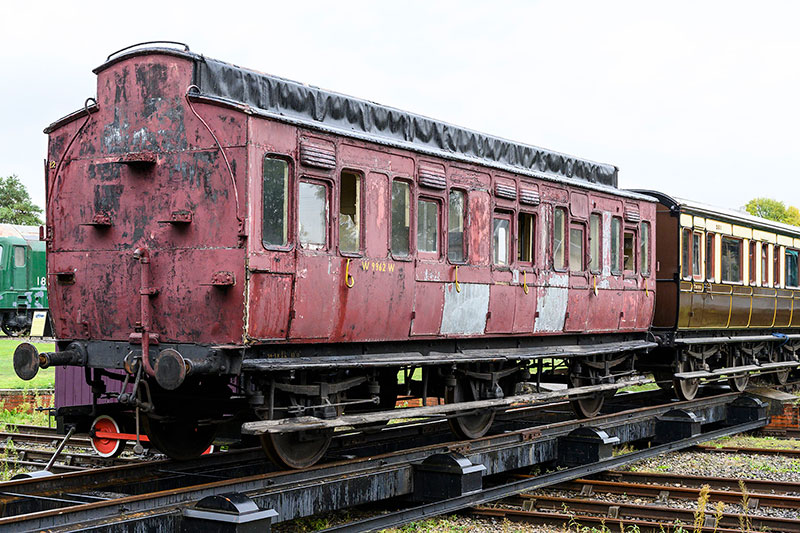
The Dean clasp brake gear can be seen on the first and third axles of No 820 in this photograph
*Remember those?! Better quality but lost out to VHS which became the ‘standard’.
**The space allowed around the track on a railway that a vehicle is allowed to occupy before it starts hitting structures such as tunnels, bridges and platforms.
***Until 1956 when British Railways changed third class to second class.
FRIDAY 7 APRIL
A Victorian Treasure Hunt…
There is an amazing collection of rolling stock at Didcot and some of it is really quite old! As a guide to the wonderful Victorian Weekend over Easter, I thought I would give you a whistle stop tour of the various Victorian Valuables we have dotted about the site.
Two things. Firstly, while they are of the right era in spirit, the broad gauge replicas have been omitted from the list. Only the real deal is here! Secondly, there are a few bits of rolling stock mentioned here that you can’t get to see as they are in storage. But I felt it was a good time to get you all to realise just how amazing this collection is! Their numbers are in italics. Without further ado…
Locomotives
We have three genuine Victorian locomotives in the collection, all of which have had a Going Loco Blog done about them in the past. You should be able to see all of these on display at the weekend, one of them is even operational!
No 5 Shannon
Shannon or Jane or Wantage Tramway Company No 5 or whatever you want to call her is our oldest resident. Built way back in 1857 by George England & Co. She has a local connection, being used on the famous Wantage Tramway up until its closure at the end of WWII. From here, she was preserved at Wantage Road station before becoming part of the National Collection with us as her custodians.

No 1338
No 1338 is a fantastic little 0-4-0 saddle tank loco built by Kitson of Leeds in 1898. The last surviving locomotive from the independent Cardiff Railway, she was absorbed into the GWR at grouping in 1923 and became British Railways property at nationalisation in 1948. She lasted in service until the 1960s!
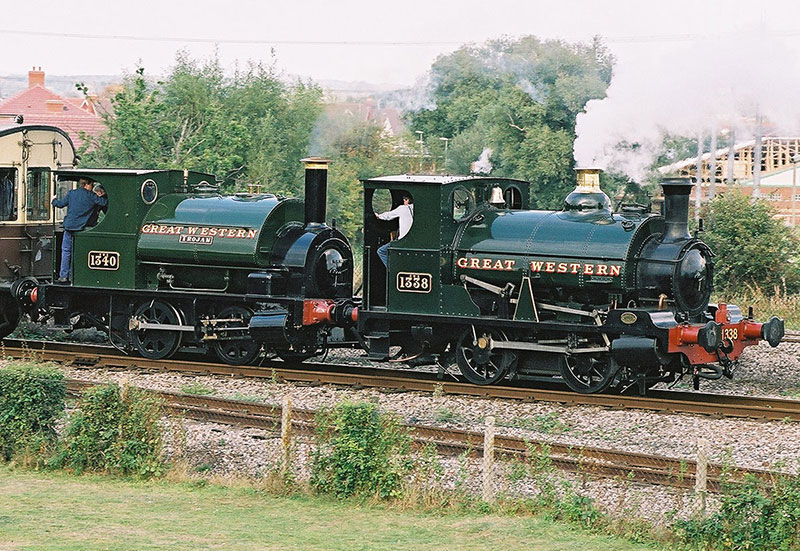
1340 and 1338 running together in 2002
No 1340 Trojan
The last surviving locomotive from the Alexandra Docks Railway, built in 1897 by Avonside. Although she was only Great Western for a few years after the 1923 Grouping, she served the nation during the war working coal trains at a mine and finished her working life at a paper mill. She is currently the oldest operational Great Western locomotive.
Coaches
A total of no less than seven of the coach fleet were built up to 1901, the year Queen Victoria passed away. That’s quite a large figure. Not all of them are restored however so they aren’t all on display. I’ll tell you which is which! Some of these vehicles survived as Camp Coaches. This is exactly what it sounds like – they were parked in holiday spots and you could hire them out much like a caravan. The interiors were converted accordingly.
No 416

This is a typical 4-wheeled coach of the era. Built in 1891, she is a brake third, meaning that she has a guard’s compartment and seating for third class passengers. Unlike modern coaches, most Victorian coaches have no corridor to allow you to walk from coach to coach. This one survived by being converted to a camp coach.
No 820

A former broad gauge carriage on the main line in 2022! This is No 820 being delivered to the Railway Centre
This is a Tricomposite convertible 6-wheeled coach! What?! Tricomposite means that it had seating for First, Second and Third Class passengers. Second class was abolished in the early 20th century. No, not a slide back canvas roof(!), convertible means that it was built so it had a broad gauge chassis but was capable of being converted to run on standard gauge. Again, this one did time as a camp coach.
No 933

This is an example of a Victorian Full Brake. She is a passenger coach outline with a guard’s compartment, but with no seats. They were used for luggage and parcels traffic. This one survived by being used as an office inside Hockley Goods shed!
No 1941
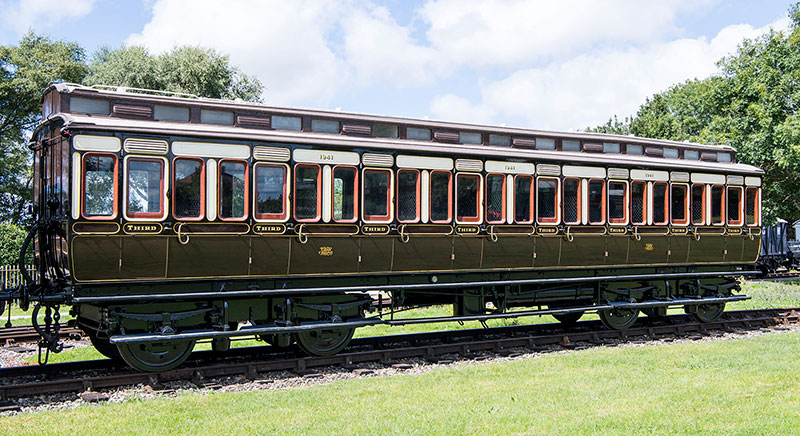
Only just a Victorian, as she was built in 1901. This is a typical all Third Class, late Victorian coach and you can see that she is starting to look modern. She has got a lot longer and has two bogies* or swivelling wheel sets at the ends so she can go around corners. She still does not have a corridor though. That came later. We do have another of these coaches in storage but No 1357 was built in 1903 and therefore doesn’t count for our list!
No 2511
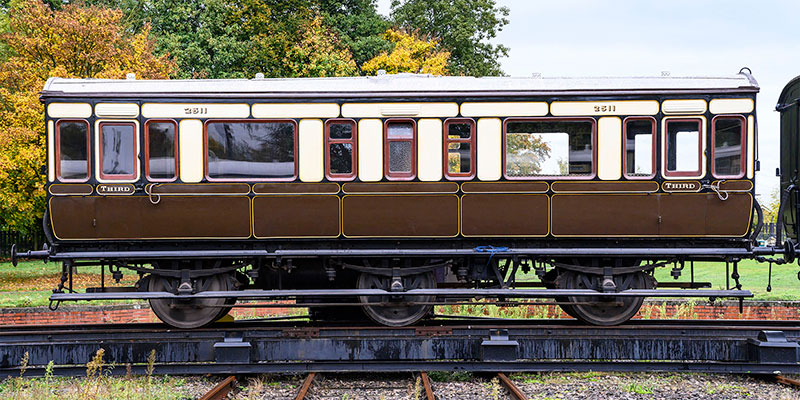
The amazing Dean family saloon. I’ve done a full Going Loco on this one but suffice to say it survived by being a house! No. 10 River Gardens, Purley-on-Thames. Take a look through the windows and you will see a remarkably complete period interior.
No 6824
The same as No. 820. Only the body has survived. Perhaps this means it would be a great idea to restore this in broad gauge condition?
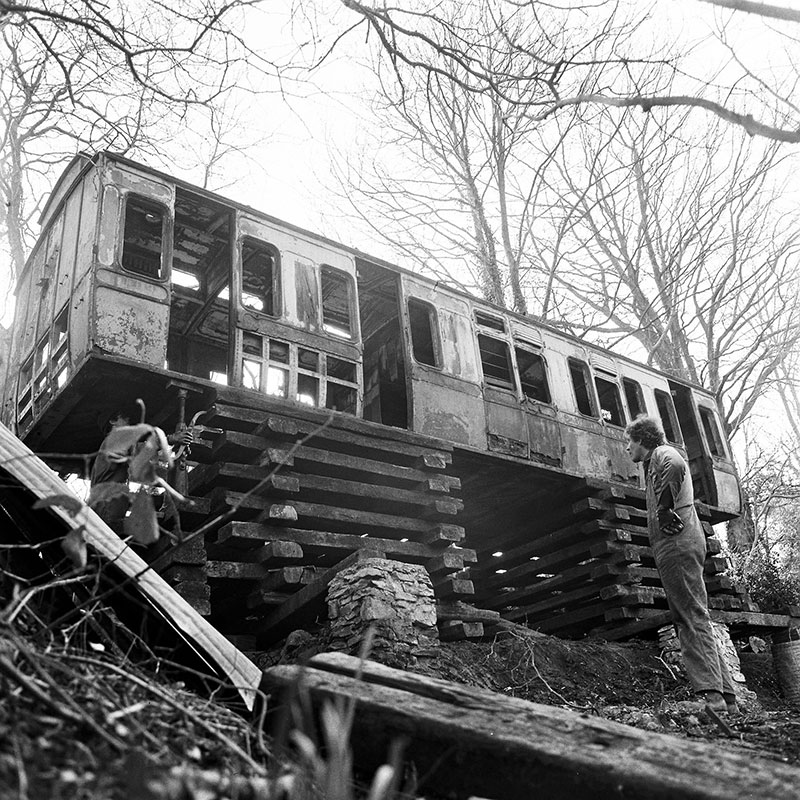
6824 on a Welsh hillside in 1974, being jacked up to road level for transport to Didcot
No 250
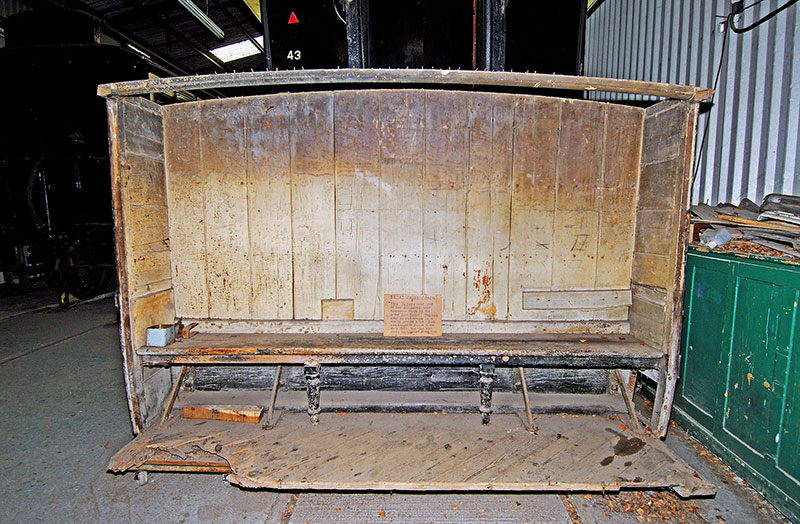
This is a bit of an enigma. It is the remains of a broad gauge coach, more than ten feet wide, built for the Bristol and Exeter railway. We don’t know exactly what it was and where it was used in service. We do know that the body was taken off and it was used as a shelter for forestry workers. There is graffiti in it from the Land Girls – the female workers that tended the farms during WWII!
Wagons
There are seven wagons that can claim Victorian heritage.
No 1 Tar Wagon

This was built in 1898 by Charles Roberts. It was acquired from the once-extensive industrial railway at Slough Trading Estate. It is in need of restoration, but it is an interesting example of early wagon building techniques with timber frames.
No 11152
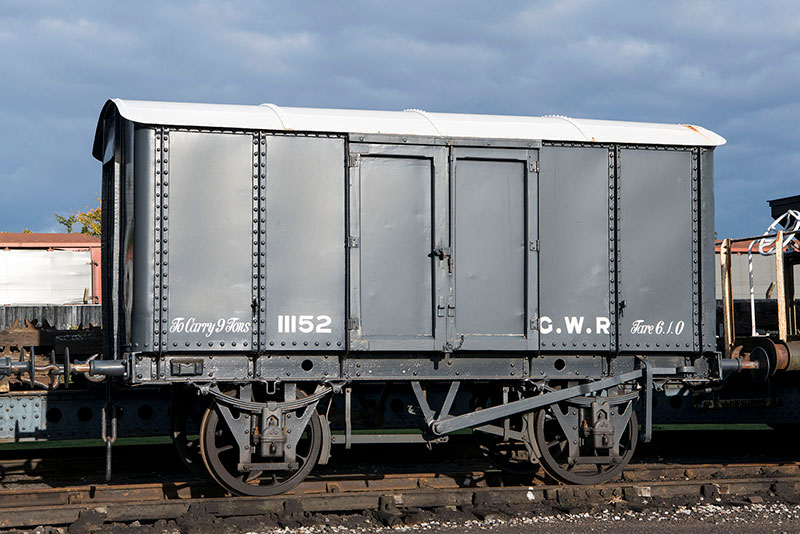
Built in 1900. This is an example of the famous IRON MINK type of 4-wheeled covered goods wagon. There is a full Going Loco blog on these. They were extremely long-lived vehicles, lasting well into the 1960s.
Nos 32337 & 32338
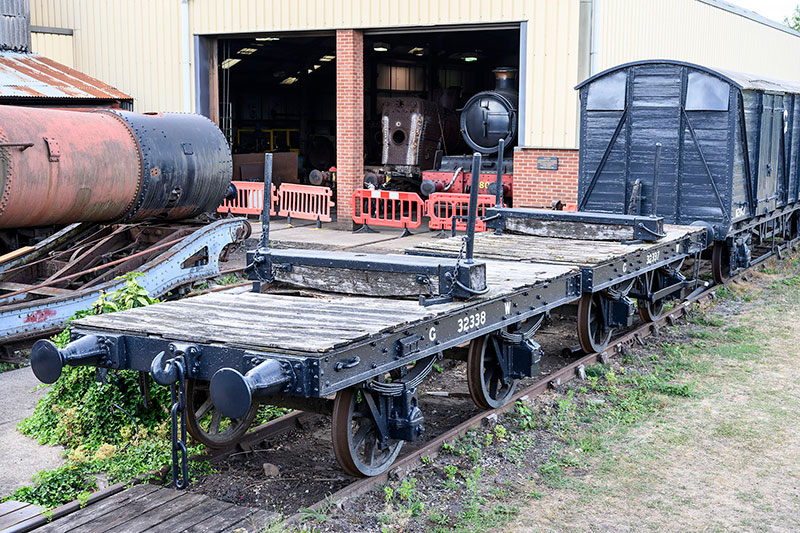
The TWIN MITEs or MITE Ds were built in 1881. They are known as bolster wagons. They have a large beam on each of them and the load - usually long lengths of steel, rail or wood - were chained to each of them. The bolsters can swivel and this allows the load and the wagons to go around corners.
No 43949
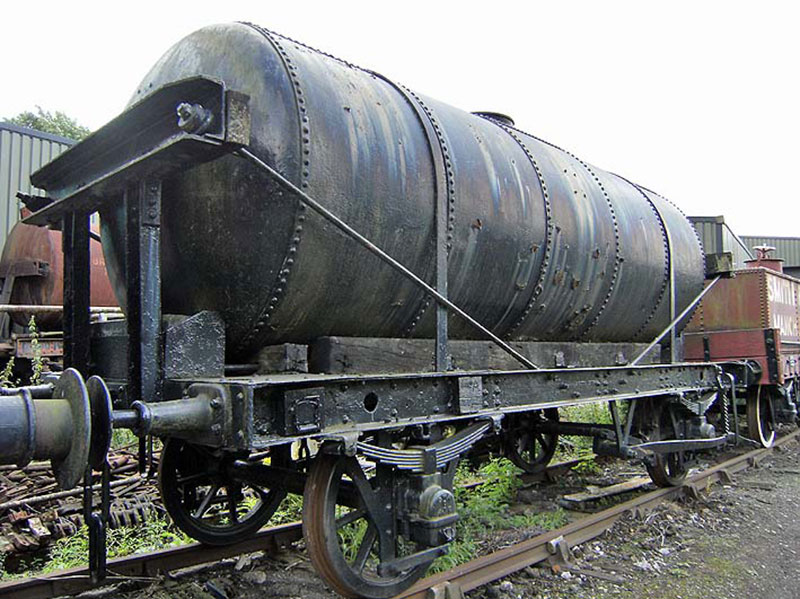
This is a rare example of a GWR-built tanker wagon. Most of this type of vehicle were built by the companies (oil and other chemicals usually) that used them. The GWR only built a few of their own and this is one of them. As such, it is quite a rare beast! Also another ‘only just Victorian’, being built in 1901.
No 47886
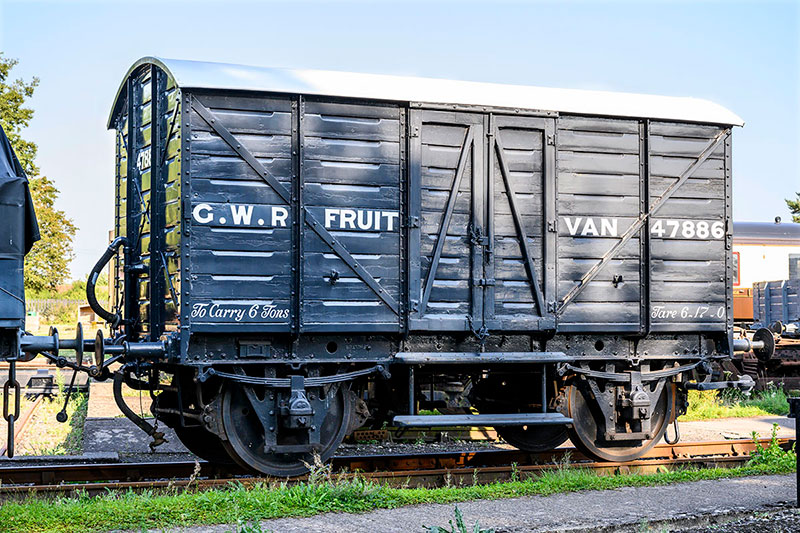
This is one of 20 vans built in 1892 to carry fruit. The sides are louvered for ventilation and she is fitted with vacuum brakes to run in passenger trains, allowing the contents to arrive fresh. She currently carries the 1904 GWR livery.
No 56400

This is the oldest TOAD brake van in the collection. She is currently unrestored and being used as staff accommodation. This was built in 1900 to diagram AA3.
Hand Cranes
There are two hand operated cranes in the collection, both of Victorian heritage.
No 205

205 being used to lift the body of No 2511 on arrival at Didcot in 1972. In those days we could ask the local BR staff to move the crane across to the Provender Yard so we could unload heavy goods which arrived by road
Number 205 is a GWR 12 ton travelling hand crane, built at Swindon Works in 1894. This did exactly what it says on the tin(!), it was a handy and mobile way of lifting loads of up to 12 tons.
No 537
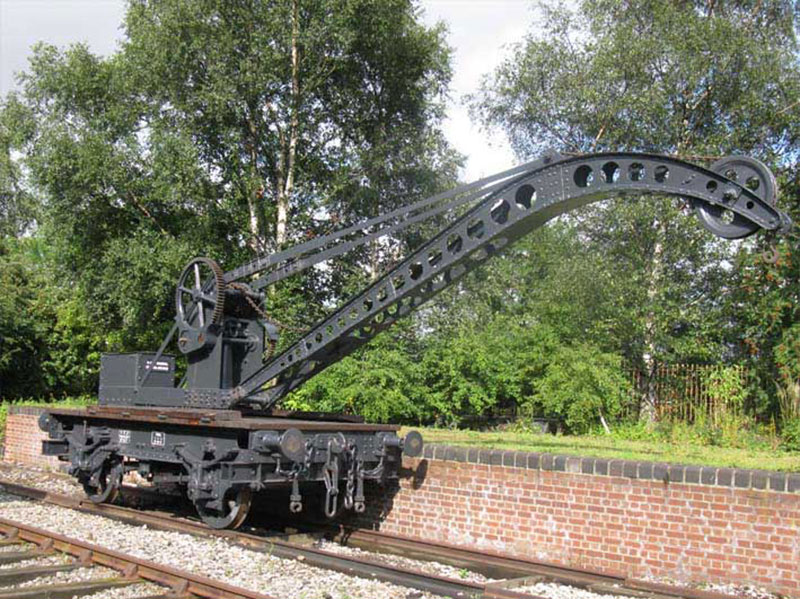
This was built in 1899, and is an example of a once common type of vehicle that was used to load and unload wagons in goods yards. It has a load of up to 3 tons.
Enjoy discovering the rich Victorian heritage that we have to offer at our Victorian weekend or indeed at any time during the year! Over the Victorian Weekend, our visiting locomotive – Furness Railway No 20 of 1863 – will be in operation as well as 1340 and costumed re-enactors, a chance to sample our very own beer and lots, lots more. I hope to see you there!
Didcot Railway Centre Newsletter
Stay up to date with events and what's going on at Didcot Railway Centre.
You may unsubscribe at any time. We do not share your data with 3rd parties.